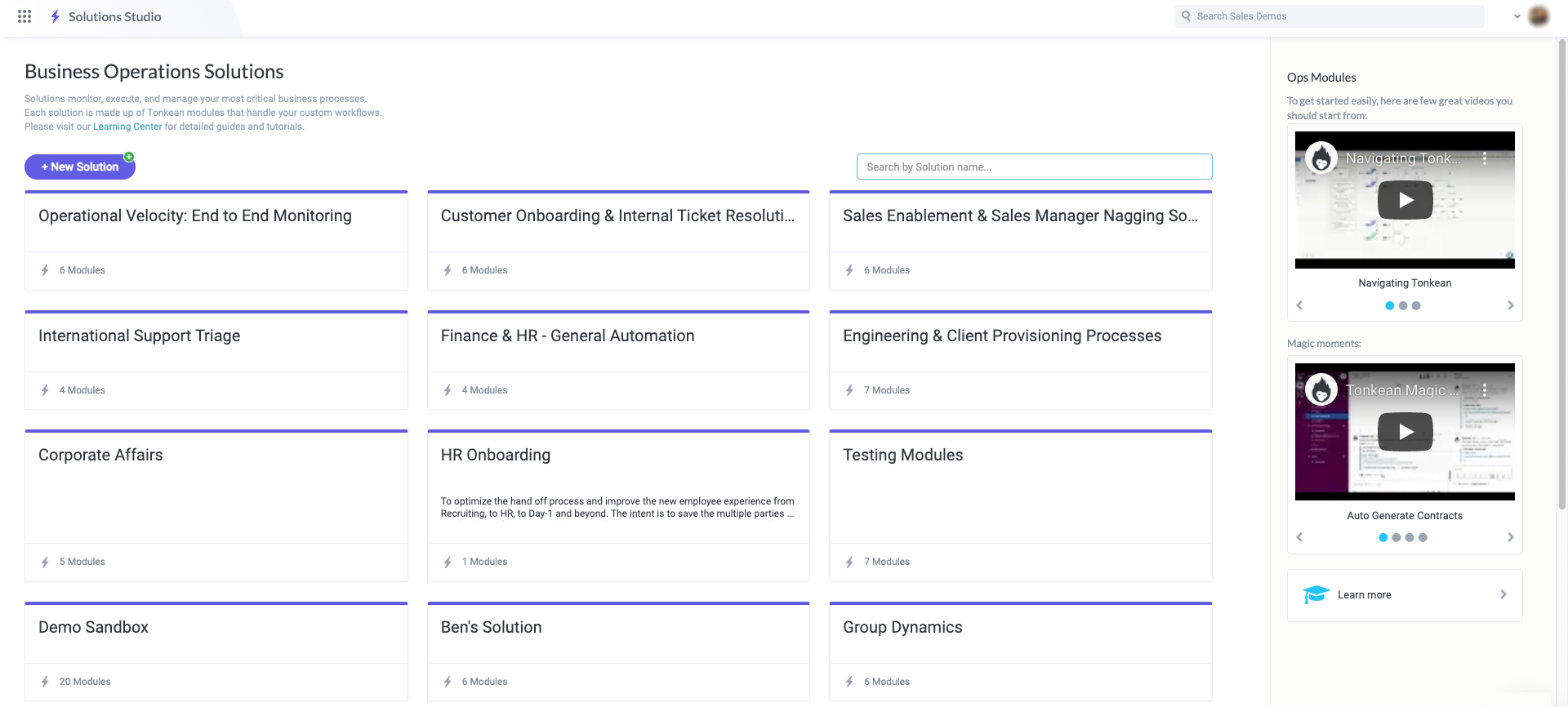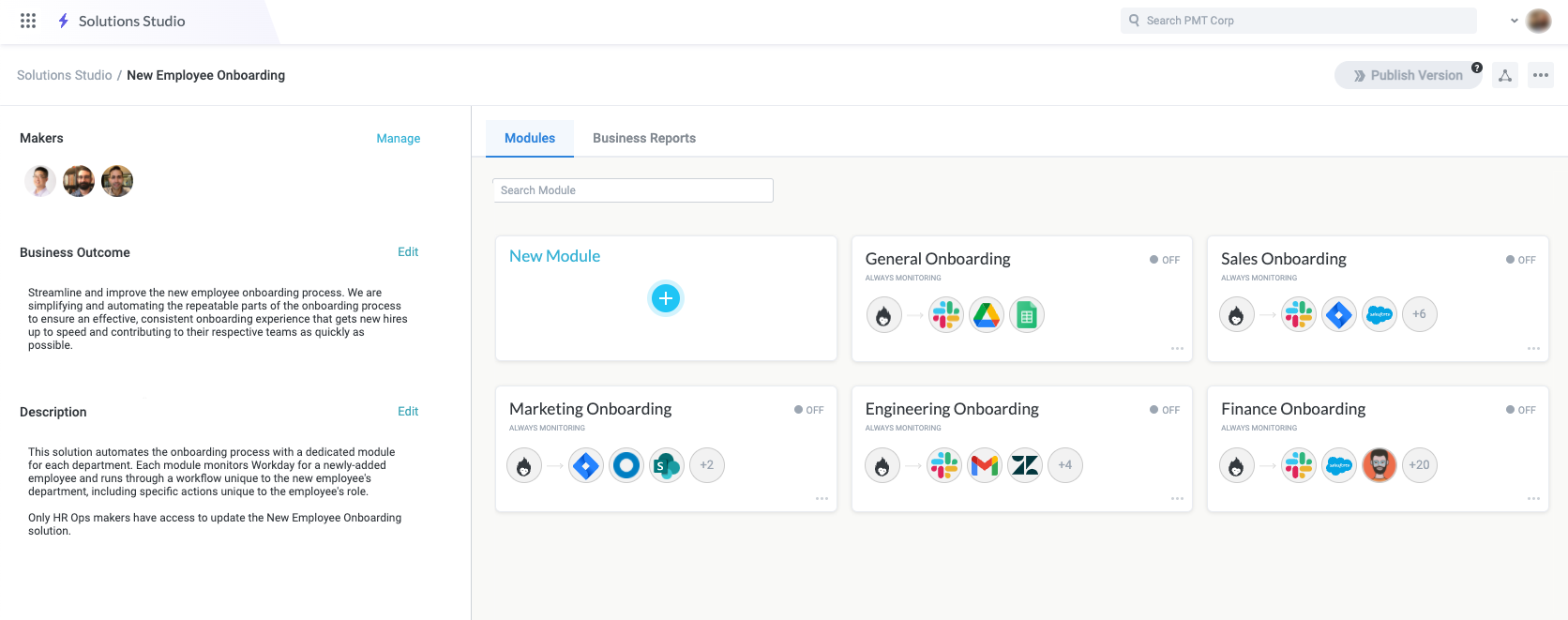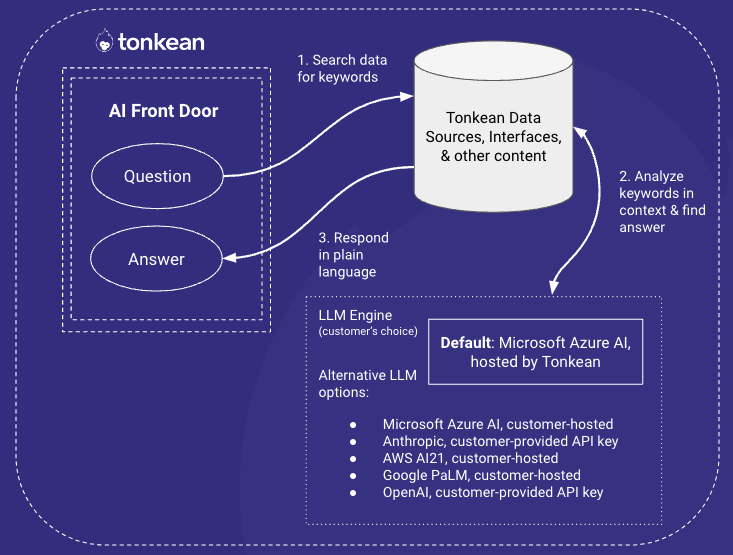Frequently Asked Questions
Below are many of the frequently asked questions we receive from current and prospective users, organized by category.
If you aren't able to find the answer to your question here or in the documentation, contact technical support through Tonkean Supports & Services or by contacting your board admin.
What's the difference between a board, solution, and module?
In one sense, boards, solutions, and modules all act as containers at different levels in Tonkean to help organize your workflows, but they're far more than simple containers. Each serves an important purpose in structuring and guiding your process orchestration:
Board
A board is the highest point in the Tonkean hierarchy and can contain many solutions. Boards are usually specific to an entire enterprise, with one board containing all the solutions for that enterprise. If your organization has unique needs surrounding business unit structure, reporting needs, or governance, you can organize your content into multiple boards.

Solution
The solution is the core of the Tonkean platform: it contains the description of a business problem, the planned and ongoing approach to solve that problem, and all the logic (that is, the modules and enterprise components) that address the business problem. Solutions also include the workspace app and business report, which allow users to gain important insights into the overall process.

Module
Each solution is made of modules. Modules house all the custom workflows, connect all of your data sources together, and give you the power to take actions based on the criteria you set up. Within each module, Tonkean provides you the ability to say "when" an event happens, the module takes specific actions.
Modules are typically built and organized as distinct, operational workflows or automations that orchestrate business processes between people, systems, and applications. This organization allows modules to remain simple to understand as they are iterated on and enhanced over time.

What's Tonkean's uptime?
Tonkean's uptime averages 99.99%. You can visit the status page at any time to check the status of Tonkean systems and check any past incidents. We communicate with customers if any substantial downtime is planned for maintenance.
Do I need a dedicated Tonkean user account or license to connect to an application?
While not necessary, we recommend using a dedicated service account (for example, tonkean@yourcompany.com) that's licensed with the application you want to connect to Tonkean. For example, if you're connecting Salesforce as a data source in Tonkean, we recommend using a dedicated service account with only the permissions necessary (read/write access) for your specific use cases.
Tonkean provides controls for admins to determine which makers have access to which data source, so you don't have to be concerned with managing detailed permissions in the connected application.
Additionally, the data source connections are implemented in such a way that each data source has access to specific solutions, providing another layer of security and access control. However, you can use a single data source in multiple solutions and modules, so there's no need to create multiple connections to the same account.
We do not recommend connecting individual user accounts to Tonkean. When roles change or challenges in a process arise, a connection to a personal account can cause additional problems.
Do makers need their own license in a connected data source to use that data source in Tonkean?
No, makers don't need their own license or account in a connect data source to create or modify modules that use that data source. In most cases, makers are using applications connected using service accounts, so they don't need (and in most cases, shouldn't have) their own accounts. However, it can be helpful for the relevant maker to have access to the connected application so they can confirm whether the Tonkean solution is producing the desired results in that application—that is, whether the module they're configuring is behaving as expected.
Remember that admins have control over which makers have access to a given data source. We recommend using these controls to ensure each user has the appropriate access, and not greater access than is required.
What permissions does Tonkean need for my connected data source?
Tonkean needs permissions to perform only the functions required by your particular use case—no more. For example, if you're using ServiceNow as a connected data source and your solution only requires read permissions, you do not have to grant Tonkean edit permissions in ServiceNow. If you configure the appropriate permissions in the application you connect to Tonkean, any user in Tonkean will be unable to perform actions not explicitly allowed by the permissions level you set.
We recommend using a dedicated service account to connect an application to Tonkean as a data source. In addition to being a general best practice for a variety of reasons (for example, change management), having a service account allows you to set the desired permissions in a single location and have those settings apply anywhere that data source is used in Tonkean.
Can I assign a non-admin user in an application to manage that application's connection in Tonkean?
Yes. A user does not need to be an admin user in the connected application to manage that application's connection to Tonkean. That is, a user doesn't need to be a Salesforce admin to manage a Salesforce data source in Tonkean.
You can set administrators for any data source (they're called IT admins in Tonkean). These admins have privileges like customizing data retention policies and creating custom actions. You can add IT admins in Tonkean by following the steps below:
Navigate to the Enterprise Components screen.
Select the data source you want to add an IT admin for. The data source configuration screen displays.
Select Admins in the data source configuration panel. The Manage IT Admins screen displays.
Select the text box and enter the names of the users you want to add as admins.

Admins in Tonkean can also control which users can connect each kind of data source, specify that only board admins can connect data sources, or configure a group of data sources users can connect to by navigating to the Board Settings and selecting Data Sources in the configuration panel.

Admins can be set at the board level or the module level, depending on your needs.
Can Tonkean use custom object types from my connected application?
Yes. Generally, Tonkean can use and update all object types, both standard and custom, from a connected data source as long as the relevant permissions are configured to allow it and those object types are supported by the application's API.
If you're having trouble with Tonkean not using a particular object type from a connected application, please contact support.
In addition to receiving data and updates, can Tonkean also push data into my connected application?
Yes, Tonkean connections are generally bi-directional as long as the permissions are configured to allow it. For example, if your solution includes a connected Salesforce instance and your workflow involves using a Slack button to ask someone to change the Next Steps field in a given Opportunity, when that person selects that button, Tonkean updates the Next Steps field in the Opportunity. You can track who selected the button in Slack, but if you look up the update history for that Opportunity, the account that updated the field is the services account you have connected to Tonkean.
What if Tonkean doesn't have a native data source for my application?
We are always adding to our list of available data sources, simplifying and streamlining the connection process—but some users may need to integrate with a system or app we haven't gotten to yet. In that case, you have a few options:
Contact Tonkean Support or your Customer Success Manager and request the addition of your needed application as a native data source. With the necessary access and available documentation, we can usually create new native data sources quite quickly.
Create a custom data source for your application using our no-code data source feature. While this feature is generally recommended only for admins and technical users, it's a powerful self-serve option that can enable you to create exactly the data source you need when you need it.
Create a custom data source for your application using one of our other options. These options include creating a custom data source that lives exclusively in Tonkean, uploading data using CSV, or setting up a webhook.
How does Tonkean leverage artificial intelligence (AI)?
AI is integral to the Tonkean platform—the most obvious features being the AI Front Door and the AI Concierge, where internal users can use plain language to ask questions, submit requests, and get context-sensitive help. These features combine to form the Enterprise Copilot, a suite of generative AI capabilities that streamline and support the process experience for requesters and other stakeholders.
Tonkean generative AI features use customer data as reference and context, not as training material.
Tonkean has numerous other AI capabilities that work behind the scenes in the module workflow:
Training sets are a natural language processing (NLP) feature that allows you to extract and classify text from documents and use that text in your modules.
Optical character recognition (OCR) is an important machine learning component of many AI-powered workflows, allowing you to identify and extract text from a digital image like a PDF.
Native integrations with popular AI providers like OpenAI, Google, and Anthropic offer access to a wide range of generative AI and machine learning models (LLMs), including GPT-4.
What is the AI Front Door and how does it work?
The AI Front Door is the go-to place for internal users to ask questions and submit requests from your shared services teams, without needing to understand complex processes or policies. The AI Front Door is powered by Microsoft Azure OpenAI. It leverages the forms and data sources in your solutions as context to answer questions, initiate processes, and perform other tasks configured in your modules.
The AI Front Door does not train the model on your data. Instead, it selectively and strategically accesses the data in your enabled forms and data sources to act as context and reference to serve requesters. For example, if a member of the sales team asks how long the opportunity with ACME Inc. has been open, the AI Front Door locates the record for ACME Inc. in your connected Salesforce data source, calculates the number of days it's been open, and returns that to the user. For a more detailed explanation of the different ways the AI Front Door searches for information in your Tonkean instance and connected systems, see Set Up the AI Front Door.
To set up and begin using the AI Front Door in your process, contact Tonkean Support or your dedicated customer success manager.
The process can vary depending on the request type, but generally goes through the following steps for a basic question:
A user submits a question or request: "Do we have an NDA for Corellia Labs?"
Tonkean identifies keywords and phrases ("NDA" and "Corellia Labs") and then sends them to the LLM (either the default model or your preferred connected model).
The LLM analyzes the keywords and phrases in the context of your connected data sources, interfaces, forms, and other content and finds the content or information that has the highest probability of being a match for the request. It may find, for example, the existing mNDA with Corellia Labs stored in your OneDrive instance.
The LLM generates a plain-language response with a link to the NDA if it exists or, if there's a process for creating a new NDA, provides the option to begin that process.
Tonkean replies to the user with the LLM-generated information.
See the diagram below for a simplified version of the process:

How can I enable the AI Front Door to access my content?
By default, access via the AI Front Door is turned off. To enable access, you must navigate to each resource and enable Tonkean AI to access it. For more information about enabling access, see Enable AI Front Door Access to Your Content.
Once access is enabled for the AI Front Door, anyone with access to the AI Front Door has access to the data contained in that data source, regardless of the permissions in the third-party application or system.
How can I improve the accuracy of the AI Front Door?
The accuracy of the AI Front Door is directly related to the amount of information in the AI-enabled interfaces, forms, and data sources in your solutions. The more detailed and complete the information, the more accurate the Front Door will be.
There are specific steps you can take to improve Tonkean AI accuracy and results for different kinds of resources (interfaces, forms, data sources, etc.). For more information about improving the accuracy of the AI Front Door, see Optimize Content for the AI Front Door.
How does Tonkean communicate with third-party applications using APIs (and how often)?
Tonkean communicates with connected applications in two main ways: the “collect,” where it sends a request for updates to the application at a specified interval (every 10 minutes is the default), and any updates to data in the application that come from actions in a Tonkean module (for example, updating a field in Greenhouse using a specific data action).
Generally, each collect requires an initial request to update the access token, and then a request for each entity type (for example, Opportunities, Accounts, or Contacts in Salesforce). If there are a large number of updates, responses to these requests are paginated and will require as many calls as is necessary to receive all the data. That is, the number of calls is equal to the number of entities, compounded by the number of pages needed for each response.
For updates made in a connected application by a Tonkean module, there are usually a minimum of three requests: one to update the access token, one to update the information in the application, and one to update that same data in Tonkean.
The specific number of calls between Tonkean and a connected third-party application varies, sometimes significantly, from one application to another, but in general, Tonkean is designed to be as efficient as possible with the number of requests and the frequency the system is updated at.
Can I limit the number of times Tonkean pushes updates (that is, sends an API request) to my external application connected as a data source?
No, Tonkean does not track the number of API calls made from Tonkean to third-party applications, nor does it have a "rate-limit" feature. Because Tonkean is an asynchronous platform, it’s not designed to call connected applications in real-time (that is, every few seconds). Rather, it performs a collect every 10 minutes for most applications.
For the vast majority of use cases, Tonkean does not generate a large enough volume of API calls to approach the rate limits for most applications. And, in those situations where a workflow does generate a large volume of requests, there are ways to mitigate that volume with changes to the module workflow.